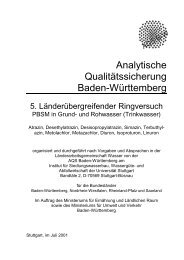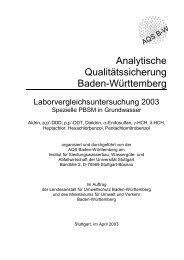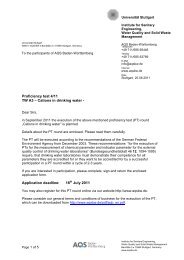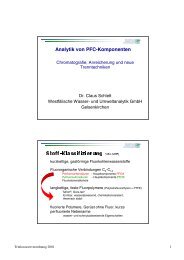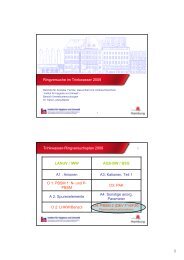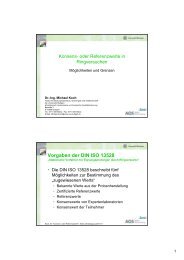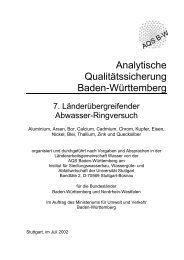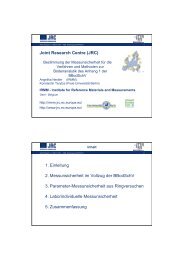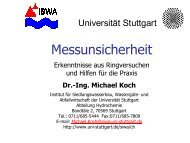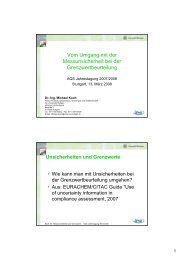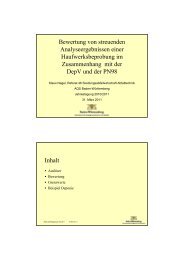Institute for Sanitary Engineering, Water Quality and Solid Waste ...
Institute for Sanitary Engineering, Water Quality and Solid Waste ...
Institute for Sanitary Engineering, Water Quality and Solid Waste ...
Create successful ePaper yourself
Turn your PDF publications into a flip-book with our unique Google optimized e-Paper software.
Chair of <strong>Waste</strong> Management <strong>and</strong> Emissions<br />
or actions <strong>for</strong> climate protection, precise values are<br />
needed by theoretical estimations or qualitative measurements.<br />
As propagation model, a lagrangian partical model is<br />
used <strong>and</strong> the concentration measurements were per<strong>for</strong>med<br />
as open-path-measurements in distances up<br />
to over 500 m. According to the measuring results, the<br />
emitted gas will be evaluated by an adapted dispersion<br />
model.<br />
ated. Hence the supplying industries <strong>and</strong> foundries are<br />
motivated, to solve the upcoming odour problems with<br />
the help of <strong>for</strong>ming auxiliary agents; <strong>and</strong> to approach<br />
an optimization <strong>and</strong> a sustainable improvement of<br />
wide scope.<br />
The cooperation of ISWA in this project was mainly related<br />
to the development of the measuring technique,<br />
in order to evaluate the emissions of different <strong>for</strong>ming<br />
auxiliary agents in odour technical aspects. The analytical<br />
procedure <strong>for</strong> odorous substance detection is<br />
described in detail as follows:<br />
• With variation of adsorption- <strong>and</strong> desorption-conditions<br />
in thermal desorption procedure, even odorous<br />
substances with lower mass numbers could be<br />
recorded by the analysis.<br />
• Extension of the detector system: with an additional<br />
flame ionization detector, a precise quantification<br />
of odorous relevant compounds could be<br />
achievable. The GC/MS/FID-System, in conjunction<br />
with the Olfactory-Detection-Port (ODP), which is<br />
also called Sniffing-Detector, proved itself useful on<br />
this problem as well as other applications.<br />
Gasfinder measurements over a l<strong>and</strong>fill<br />
Project promoter:<br />
DBU – Deutsche Bundesstiftung Umwelt, Osnabrück<br />
Project partner:<br />
Ingenieurbüro Lohmeyer, Karlsruhe<br />
Duration:<br />
09/2009 - 03/2011<br />
Contact:<br />
MSc. Zhu Han<br />
Dr.-Ing. Martin Reiser<br />
Minimization of odour emission in foundry<br />
sections – Part II<br />
In a research project which was completed in 2008,<br />
the basics of olfactory (odour technical) evaluation of<br />
the <strong>for</strong>ming auxiliary agents in foundries was accomplished.<br />
These kinds of <strong>for</strong>ming auxiliary agents, such as adhesives,<br />
feeder heads, refractory dressings <strong>and</strong> s<strong>and</strong><br />
additives, make a great contribution to the odour balance<br />
of moulding in s<strong>and</strong> <strong>for</strong>m. Quantity <strong>and</strong> importance<br />
of the odour contribution was defined <strong>and</strong> evalu-<br />
„Olfactory-detection-port (ODP) “<strong>for</strong> identification of<br />
odorous components in mixed gas<br />
Financing institution:<br />
AIF Arbeitsgemeinschaft industrieller Forschungs<br />
vereinigungen, Köln<br />
Project partner:<br />
IfG – Institut für Gießereitechnik gGmbH, Abteilung<br />
Arbeits- und Umweltschutz, Düsseldorf<br />
Duration:<br />
10/2005 - 03/2008<br />
Contact:<br />
Dr.-Ing. Martin Reiser<br />
104




